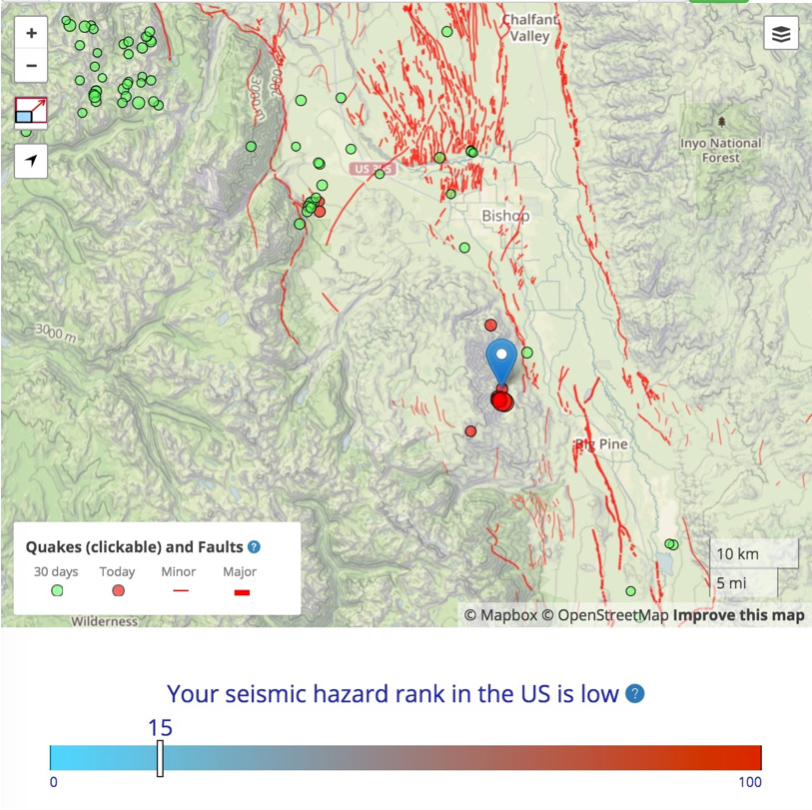Magnitude-4.8 shock near Big Pine, CA, strikes just north the 1872 M=7.6 Owens Valley quake, recalling the contemporary account of naturalist John Muir
16 February 2016 | Quake Insights
The M=4.8 Big Pine, CA quake was followed by a M=4.2 aftershock and several smaller ones; both are right-lateral ruptures at a depth of about 15 km (9 mi). They struck in a very active belt of the 'Walker Lane' active faults and volcanic features.
 Temblor map of today's M=4.8 mainshock and several aftershocks. The northern end of the 100-km-long (60 mi) 1872 M=7.6 Owens Valley rupture extends through the 'g' of Big Pine.
Temblor map of today's M=4.8 mainshock and several aftershocks. The northern end of the 100-km-long (60 mi) 1872 M=7.6 Owens Valley rupture extends through the 'g' of Big Pine. The 1872 M=7.6 Owens Valley earthquake is the third largest shock to strike California since reliable accounts began in about 1800, exceeded only by the 1857 M=7.9 and 1906 M=7.7 shocks on the southern and northern San Andreas faults respectively. Although the magnitudes of pre-instrumental quakes are uncertain, the surface slip and rupture length was carefully mapped by Lubetkin (1988) and Beanland and Clark (1994), and so only it's depth extent is uncertain. As a result, few doubt that this was the third largest California quake.
 The Walker Lane belt is perhaps the eastern periphery of the North American-Pacific plate boundary shear zone, of which the San Andreas is the most prominent feature. The belt accommodates right-lateral shear, but there also extension aligned roughly northeast-southwest. This extension gives rise to the 'normal' (extensional) faults that form the eastern margin of the Sierra Nevada (snow covered rocks in the lower left), and also to active magmatic cones (the dark brown conical features in the center bottom) that are cut and right-laterally offset by the Owens Valley fault. (Temblor Map)
The Walker Lane belt is perhaps the eastern periphery of the North American-Pacific plate boundary shear zone, of which the San Andreas is the most prominent feature. The belt accommodates right-lateral shear, but there also extension aligned roughly northeast-southwest. This extension gives rise to the 'normal' (extensional) faults that form the eastern margin of the Sierra Nevada (snow covered rocks in the lower left), and also to active magmatic cones (the dark brown conical features in the center bottom) that are cut and right-laterally offset by the Owens Valley fault. (Temblor Map) Right-lateral slip on the Owens Valley fault during the past 20,000 years is 1-4 mm/yr, according to Beanland and Clark, 1994 and Lubetkin, 1988, or about a tenth of that on the San Andreas. So great shocks on the fault must be much less frequent, but no less damaging, than on the San Andreas. The 1872 earthquake produced right-lateral offsets averaging about 6 m (20 ft) along the 100 km fault length, according to Beanland and Clark (1994).
 In this Google Earth image, North is oriented to the lower right. The diagonal is about 100 km (60 mi). The 1872 M=7.6 rupture is red, whereas the normal faults bounding the Sierra Nevada are yellow (if active in the past 20,000 yrs) and blue (if active only sometime during the past 2 million years).
In this Google Earth image, North is oriented to the lower right. The diagonal is about 100 km (60 mi). The 1872 M=7.6 rupture is red, whereas the normal faults bounding the Sierra Nevada are yellow (if active in the past 20,000 yrs) and blue (if active only sometime during the past 2 million years). The great John Muir, founder of the Sierra Club, and champion and defender of Yosemite, was camped in Yosemite Valley at the time of the 1872 quake, and witnessed massive rockfalls in response to the shaking. Beautifully capturing the excitement we all feel when the earth reveals her dynamism to us, he wrote in his journal,
"…though I had never before enjoyed a storm of this sort, the strange, wild thrilling motion and rumbling could not be mistaken, and I ran out of my cabin, near the Sentinel Rock, both glad and frightened, shouting, 'A noble earthquake!' feeling sure I was going to learn something. The shocks were so violent and varied, and succeeded one another so closely, one had to balance in walking as if on the deck of a ship among the waves, and it seemed impossible the high cliffs should escape being shattered."
Ross Stein and Volkan Sevilgen
Data from USGS, California Geological Survey; Sarah Beanland and Malcolm Clark (1994), The Owens Valley fault zone, eastern California, and surface rupture associated with the 1872 earthquake, U.S. Geol. Surv. Bull., 1982, 1–29; Lester Lubetkin (1988), Late Quaternary activity along the Lone Pine Fault, eastern California, Geol. Soc. Am. Bull., 100, 755–766; Steven G. Wesnousky (2005), Active Tectonics of the Walker Lane, Tectonics, 24, doi:10.1029/2004TC001645.
--
__._,_.___

No comments:
Post a Comment